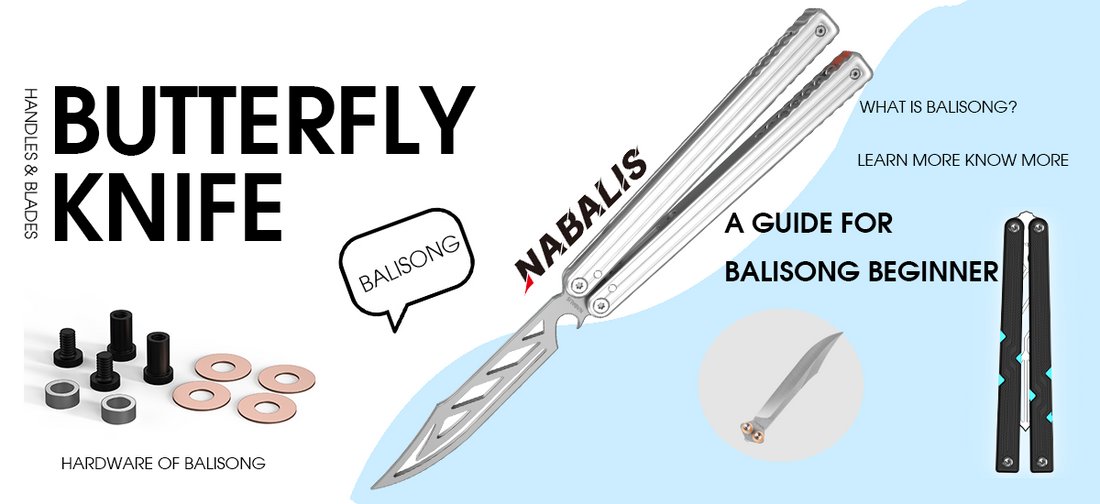When I first picked up a butterfly knife as a beginner, my mind was blank. I had no idea about anything except for the blade and the handle. Being a memeber of this community, it was quite embarrassing.
So, I started asking around and researching, and finally, I gained some understanding about butterfly knives themselves. Do you want to know? Definitely! Alright, I'll tell you right away.
What is balisong
A balisong, also known as a butterfly knife or fan knife, is a pocket knife characterized by two handles that rotate, allowing the blade to be concealed between them.
Traditionally made in the Philippines, and this guide will outline the fundamental structure of most balisongs, exploring their craftsmanship and materials.
Essential parts of balisong anatomy

Blade of balisong
Tang: The rear section of the blade where the handles are connected.
Edge: The outer outline of the blade that is sharpened and employed for cutting purposes.
Spine: The blunt side of the blade, opposite to the edge, used for rebounds during handling.
Tooth: A minor protrusion on the lower part of the butterfly knife balisong trainer blade designed to mimic an edge. The tooth offers tactile feedback, indicating when the user has contacted the wrong side of the blade.

Kickers are small protrusions on the bite side of the blade, similar to a choil, preventing the edge from touching the inside of the handles in a channel design. Most balisongs with kickers use a tang pin for the open position, and kickers are primarily found on CCCs these days.
Besides, balisongs are typically categorized into two types: live blades and butterfly knife balisong trainers.
Live blade: Essentially, a live blade is a functional knife with a cutting edge, posing a risk during flipping. Tricks and combos are generally based on the assumption that the balisong has a sharp edge, which is the traditional starting point.
Butterfly knife balisong trainer: Also known as a training knife, a butterfly knife balisong trainer replicates a balisong or butterfly knife but lacks a cutting edge to eliminate risks and comply with laws in places where butterfly knives are prohibited. While a butterfly knife balisong trainer is not a functional knife, many people colloquially refer to their butterfly knife balisong trainers as knives in conversation.
Handles of balisong
Sandwich Handle: Comprises two slabs of material connected by a spacer in between.
Spacer: A small block of material that separates two slabs in a sandwich handle.
Channel Handle: Machined from a single piece of material.
Chanwich: A hybrid of sandwich and channel handles, made from two pieces resembling a chopped channel handle screwed back together. It offers a balance of simplicity, durability, and modification ease, combining aspects of both sandwich and channel designs.

Safe Handle: The handle without the cutting edge. Holding this handle ensures safety, preventing cuts even upon contact with the blade.
Bite Handle: The handle with the cutting edge. Holding the bite handle risks cuts if the blade contacts your hand. Butterfly knife balisong trainers often feature indicators to differentiate without causing harm.
Scales: The outer surface material of the handle, typically situated on top of the liners.
Liners: Metal plates beneath the scales, providing structural support to the handle.
Handle Tolerance: Refers to the degree of movement or wiggle in the handles outside their regular swing, commonly known as “handle play.”
Latch: A bar located at the base of the handles, used to secure the balisong in a fixed position, either open or closed.
Jimping refers to the ridged or knurled surface often found on a knife’s liner and the base of a blade’s spine. It offers enhanced grip and adds a touch of visual appeal.
Hardware of balisong
Torx Screw: A screw with a star pattern, commonly used to hold balisongs together. The T10 torx driver, essential for maintaining your balisong, can be purchased along with other necessary tools.
Pivots: Cylindrical shafts connecting the blade and handles, enabling rotational movement.
Washers: Thin rings separating the handles from the blade, ensuring smooth motion.
Bushings: Rings inside the blade and around the pivot, enhancing handle tolerances.

Ball Bearings: Small spherical balls placed on the blade's surface or underside of the handles, greatly improving handle swing smoothness.
Zen Pins: Metal dowel pins inside the handles that contact the blade, preventing handle contact.
Tang Pins: Metal dowel pins pressed into the blade, contacting the handles to prevent touching.

Pinsless: Refers to a balisong without stop pins; the blade and handle geometry are designed for handles to stop naturally at specific positions.
Pivot Hole: The hole is located at the bottom of the blade and handles.
Except for balisong itself, you need to learn some craftsmanship & materials of it.
Craftsmanship
CNC:Computer Numerical Control (CNC) machining is an advanced manufacturing technique where pre-programmed computer software guides the movement of factory tools and machinery.
This process is versatile, controlling various complex machinery like grinders, lathes, mills, and CNC routers. CNC machining allows for precise three-dimensional cutting tasks to be completed efficiently using a single set of instructions.

Bead blasting: Blasting is a surface finishing technique employed on various objects. Bead blasting, a type of shot blasting, utilizes high-pressure to propel fine glass beads onto a surface for cleaning or finishing purposes.
In bead blasting, a specialized tool shoots bead-shaped media at high pressure onto the material's surface. The goal is to achieve a smooth, shiny, and clean surface finish.
Manufacturers commonly utilize bead blasting on materials such as metals, plastics, glass, and rubber to create excellent surface finishes.
Stonewashing is a process that employs pumice stones to impart a rich, worn appearance and increased abrasion to fabrics. Stone-free enzymes are frequently used in this process.
The effects of stonewashing can differ based on the type of fabric. Typically performed on thick cotton, this method creates enhanced abrasion, a soft, velvety feel, a distressed effect, and a rich overall appearance, among other features.
Anodizing is an electrochemical technique that transforms metal surfaces, particularly aluminum, into a durable, decorative, and corrosion-resistant anodic oxide finish.
While aluminum is the ideal candidate for anodizing, other nonferrous metals like magnesium and titanium can also undergo this process.

Materials
Most blades are made of steel. Here, we will only discuss the handle materials of butterfly knives.
The material of your handles significantly influences the feel and durability of a balisong. For beginners, aluminum handles are a popular choice due to their affordability, unless you're willing to invest in titanium handles.
Steel handles, once a standard choice, are robust and budget-friendly. However, their high density makes balisongs with steel handles too heavy for most users' preferences.
Aluminum handles offer a balance between strength and affordability, often found at lower price points. While not the most durable metal, aluminum is strong enough for most users, lightweight, and cost-effective. It's important to note the two common alloys: 6061 and 7075. The latter is stronger but comes at a higher price.

Titanium handles are widely regarded as the best choice overall. Titanium is less dense than steel, offering incredible strength and a distinct feel that sets it apart from other materials. Beyond a certain price range, titanium handles become a preferred option.
After all that, there's also some handles that have scales added on top for grip, typically made from things like G10, micarta, or carbon fiber.
Plastic handles, often found at the lower price range, are occasionally used in high-quality balisongs due to their benefits like lightweight design, quiet flipping, and a less intimidating appearance.
They come in various materials such as PVC, acetal, and in 3D printing, PLA, PETG, Nylon, etc., each with unique properties including differences in rigidity and impact resistance. This is crucial for 3D printed balisongs as PLA, for instance, can melt in high temperatures, like inside a hot car.
Embracing balisong butterfly knife, learn more, know more.
I believe that after going through all of this, as a beginner, you now have a general understanding of butterfly knives (trainers). However, this understanding is just scratching the surface.
For example, you still need to delve deeper into the origins of butterfly knives, their legality, and the butterfly knife tricks involved.
In short, you need to keep learning and continually expand your knowledge of butterfly knives. The more you learn, the more you'll love butterfly knives more and more.


